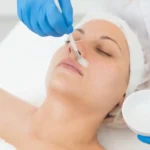
Aging in the neck and decolletage areas can often be indicative of a person’s true age. As such, it is important to treat these areas in order for your patient to retain a more youthful appearance. Unfortunately, this region is all too often overlooked when it comes to caring for the skin. Most of the time, skincare routines (which include applying skincare products and SPF for sun protection), are limited to the face, resulting in an aged appearance on the skin of the neck and decolletage.The delicate skin on the neck is extremely prone to exhibiting the signs of aging. After the eye area, it is usually 1 of the first areas of the body to develop wrinkles, partially because its structure is less elastic. When combined with other age-related factors, such as chin fullness (submental fat), sagging of the jowls, and platysmal banding, this lack of flexibility usually results in loss of the definition of the cervicomental angle, which is associated with the aging neck.1 Some other signs of aging in this area include the formation of “turkey neck,” which occurs when the neck skin loosens and sags,2 and “tech neck,” a recent phenomenon in which bending the neck to look at mobile devices accelerates wrinkling around the chin and neck area.3
For medical practitioners, the first step in treating a patient’s aging neck and decolletage is to discuss this issue with the patient and determine their concerns. Commonly, patients complain of sagging skin, submental fullness, crepey skin, and fine lines and wrinkles. During any medical consultation, it is important to also identify whether the patient has undergone previous treatments for these concerns, how long the aesthetic issue has been a concern for the patient, and how much it concerns the patient. Additionally, the patient’s lifestyle factors, such as diet, exercise, and smoking habits, as well as their daily skincare regiment and SPF usage should also be determined. This will provide insight into the type of correction that needs to be done, and whether successful outcomes can be achieved.
Luckily, a comprehensive lineup of options is available for the purposes of rejuvenating and treating an aging neck and decolletage.
Dermal fillers
Injections of hyaluronic acid-based dermal fillers can help to rejuvenate the skin of the neck and decolletage. Because these areas are delicate, dermal fillers can help diminish the appearance of aging by restoring lost volume and increasing elasticity. This form of treatment results in the diminishing of lines and wrinkles, as well as smoother, tighter skin.
Treatment with dermal fillers usually involves microinjections across any problem areas. In these instances, slight over-corrections will actually lead to better treatment outcomes, as the low-viscosity filler used for this type of treatment will settle with time and give a better final result. Effects typically last between 6–9 months, and repeat treatments are usually necessary, with products like Belotero.
Thread lift
For patients with sagging skin or jowls, thread lift procedures may be suitable. As a non-surgical alternative to a facelift, the thread lift involves inserting threads made from polydioxanone into the dermis in order to mechanically lift the skin. This lifting effect is subsequently maintained by the formation of new collagen at the site of implant,4 which occurs as the biodegradable threads slowly dissolve.
Various types of threads are available, from cogged or barbed threads, which are free-floating, to suspension threads, which require a proximal anchor. The choice of thread mainly depends on the treatment indication, be it for the purposes of lifting sagging skin, or for rejuvenating the skin.
When considering a thread lift, an important issue to contemplate is the risk for increased side effects and a longer recovery period than other non-invasive treatments, such as injectables. In terms of adverse events, thread lifting may cause swelling, infection, hematoma, seroma formation, migration of the sutures, puckering, and dislodging of the thread position, which may result in asymmetry. Some of these complications will require review and possible correction. It is therefore important that patients are aware of the risks and advantages of this procedure before agreeing to it.
Botulinum toxin
Treatment with botulinum toxin is most appropriate to correct early signs of aging in the neck and decolletage, especially slight platysmal banding and minor jowls. This treatment is sometimes referred to as the “Nefertiti lift,” and involves injections into the lower jaw and neckline.5 When treating platysmal bands, the injections are administered along the neck vertically. It is important to administer these botulinum toxin injections intradermally to mitigate the risk of toxin diffusion into deeper structures of the neck. If done improperly, this procedure may cause speech and swallowing difficulties.6
Radiofrequency, Ultrasound and Laser resurfacing
These techniques use devices that work to stimulate neocollagenesis (through triggering fibroblast activity) in skin tissue by localized volumetric thermal heating of the skin tissue. This heating action also causes its collagen fibers to contract, resulting in traction on the skin’s surface.7 With this, the skin is tightened and smoothed, and wrinkles are corrected.
Combination and “add-on” therapeutic approaches
The techniques discuss above can be used in combination with each other, and can often produce better results in this manner. Alternatively, optimal results may also be achieved by supplementing the primary treatment with other “add-on” therapies, like platelet-rich plasma (PRP) therapy, microneedling, different mesotherapy treatments, and skin peels, which aid in healing and support the rejuvenation process.
In conclusion, the neck and decolletage of an aging patient are important regions to treat in an anti-aging skincare regimen. However, this space is often overlooked by both patients and medical practitioners alike. In addition, it is important that the patient follows up any primary treatment with a comprehensive skincare and sun protection regimen that will preserve the benefits and effects of the chosen treatment. Other lifestyle adjustments, like quitting smoking, eating well, and exercising, will contribute to the overall condition of the neck and decolletage. While these areas may have once been difficult to treat, the advent of new technologies and techniques has made their rejuvenation simple to achieve.
Aesthetic medicine products are developed and regulated to meet stringent safety and efficacy standards. They are typically administered by trained healthcare professionals such as dermatologists, plastic surgeons, and specialized nurses in clinical settings. These products aim to provide effective solutions for cosmetic enhancement, skin rejuvenation, and overall aesthetic improvement, contributing to both physical appearance and self-confidence.
Key categories of aesthetic medicine products include:
-
Injectables: This category includes products such as dermal fillers, botulinum toxins (e.g., Botox), and collagen stimulators. These injectables are used to smooth wrinkles, add volume, and improve facial contours.
-
Skin Rejuvenation Treatments: Products like chemical peels, microdermabrasion systems, and laser devices are used to improve skin texture, reduce pigmentation irregularities, and enhance overall skin tone.
-
Skincare Products: These include medical-grade cleansers, moisturizers, serums, and topical treatments containing active ingredients like retinoids, antioxidants, and growth factors. They are formulated to address specific skin concerns such as acne, aging, and hyperpigmentation.
-
Hair Restoration Products: Medical treatments and products designed to promote hair growth and treat conditions such as male and female pattern baldness.
-
Body Contouring and Fat Reduction: Devices and products used for non-surgical body sculpting, such as cryolipolysis (cool sculpting) devices and injectable lipolytics.
-
Cosmeceuticals: High-performance skincare products that bridge the gap between cosmetics and pharmaceuticals, often containing potent ingredients with proven clinical benefits.
-
Wound Care and Scar Management: Products like silicone sheets, gels, and advanced wound dressings used to improve healing and reduce the appearance of scars.





